Imagine ordering a glass of wine at a bar and having it served at the perfect temperature and tasting consistently the same, time after time. "That's what [wine on tap] is all about: delivering a better glass of wine," said Jordan Kivelstadt, CEO and cofounder of Napa-based Free Flow Wines, a kegging service provider.
Four years ago, the wine-on-tap category was just emerging. Thanks to enthusiasm from wineries and growing interest from restaurants, more than 3,900 locations in 49 states now offer it, nearly double the number of locations of two years ago. "What started as a cool curiosity is now a central piece of how restaurants are built out," said Jason Haas, partner and general manager of Tablas Creek Vineyard in Paso Robles. "It was novelty in the beginning, but is increasingly how a large number of top restaurants are choosing to source their by-the-glass wines."
Free Flow works with 250 wine brands from all over the world, cranking out 250,000 kegs per year. Premium clients such as Napa Valley's Hall Wines, Sonoma's Chateau St. Jean, and Oregon's Chehalem and Ken Wright Cellars have wine in kegs at a wide range of venues, including Kimpton and Mariott Hotels, Pebble Beach Resorts and P.F. Chang's.
On the other coast, New Jersey–based Gotham Project is the nation's other large supplier of kegged wine, offering a mix of winery brands and its own brands. Gotham was founded in 2010, specializing in New York Finger Lakes wines, but quickly expanded to produce or source wine for their own proprietary labels, including imported wine. "We pioneered the import side of the business," said cofounder Bruce Schneider.
The concept is an old idea made new again. Wine on tap has a long history in Europe, where customers can visit bars or wine co-ops and fill bottles or jugs with local wines.
In the U.S., the trend is a new model for wine-by-the-glass service in restaurants. The biggest problem with wine by the glass is freshness. Open a bottle to serve one customer and you're not sure you'll sell the other five glasses before oxygen kills the wine.
Wine on tap provides restaurants with wines that stay fresh longer. Each 19.5-liter stainless steel, reusable keg holds the equivalent of 26 bottles of wine. Once it's tapped, an inert gas protects the wine from coming in contact with oxygen, allowing it to stay fresh with every pour, maintaining its integrity for up to three months, according to both Free Flow and several restarauteurs Wine Spectator spoke to.
Wendy Heilmann, director of Wine and Spirits at Pebble Beach Resorts, developed a special keg cellar at their Inn at Spanish Bay Resort, which she calls "the Hub," housing kegs of both red and white wines in separate temperature-controlled areas, feeding the taps for three separate bars at the resort. Heilmann estimates that at a roughly 5 percent spoil rate for bottles in wine-by-the-glass programs, providing wine on tap saves Pebble Beach's restaurants about $35,000 to $40,000 annually.
Keg wine is also attractive because of its environmental impact. Kivelstadt estimates that Free Flow will save 4.5 million pounds of trash from landfills this year. Over its 30-year lifespan, one keg will replace 1 ton of bottles.

Because of the durability of keg wine, restaurants are more willing to offer higher-priced wines by the glass. And vintners are happy with that, because it can allow a sommelier to introduces their wines to customers who might not be willing to buy a bottle of an unfamiliar wine. "People can now sample tastes of wines they may have been reluctant to order, and that gets people more comfortable with new wines, which is great for the industry," said Kivelstadt.
Emily Wines, senior director of National Beverage Programs for Kimpton Hotels and Restaurants, says she rarely offers the most affordable wine on tap because it's important to send a message to customers that it's not their "cheap" wine.
Kathryn Hall wishes her winery had more opportunities to be on tap. "There is a reluctance among some restaurateurs to serve premium wines from a keg," said Hall. "Eventually this will change, just like the screwcap."
Challenges still exist because wine kegs are a niche market. Despite its growing availability, the market for wine on tap is concentrated in large cities like San Francisco, Los Angeles, New York and Chicago. A wholesaler in a small market may carry 15 wine brands that offer kegs, but because they aren't familiar with the draft business and don't know where to direct restaurants to get equipment, they are reluctant to sell kegged wine.
Typically, only new restaurants that can outfit their space for wine on tap have been able to successfully develop a program—you can't just connect a wine keg to a beer tap. "We thought our biggest challenges would be with the consumer," said Schneider. "But it more comes down to the infrastructure, and that specific hardware is needed." Schneider believes as more restaurants become better equipped to serve wine on tap, it's going to be hard to beat the delivery system. "In the end it offers a better glass of wine."
Because the concept is still new, the logistics of moving kegs around the country instead of case goods have been tricky. But wholesalers are getting the hang of it. "Everyone pools empties," said Kivelstadt. "That way there's a quicker turnaround to allow wineries to refill for new accounts rather than wait for their empty to come back to us." Free Flow Wines has partnered with Gotham Project to build a facility on the East Coast.
From a cost standpoint, the packaging price doesn't vary drastically considering wineries still have to rent their kegs and pay freight charges for distribution. "We don't save a lot in the end, but the point wasn't to make a lot more money. Our goal was to get as many wines on by-the-glass lists at as many restaurants as possible," said Haas, knowing that the customer is getting a fresh glass every time.
Kegging wine does come with risk, especially for small wineries. Offering wine in kegs could grab wineries spots on coveted wine lists, but if not enough sommeliers accept, they've put more than two cases worth of wine in each keg.
Free Flow offers two kegging programs: full-service and offsite. The full-service program is for wineries that are able to ship a minimum of 250 gallons to the kegging service. The firm kegs, stores and ships the wine to distributors. The offsite program allows wineries to test the waters. Free Flow provides wineries with clean kegs and instructions on filling and shipping.
For bigger wineries that can afford to put large volumes into kegs, being part of a trending movement gives them a chance to stay fresh and innovative. "We found that the restaurants that offer keg wines open new markets for us," said Hall. "These tend to be trendier restaurants, and the clientele is a crowd we want to reach."
Gotham now offers more than 50 wines, sold in 35 states, and Free Flow has experienced a growth rate of nearly 400 percent in the past three years. But Kivelstadt says that only 0.5 percent of all on-premise wine is currently sold on tap. His goal: Reach 10 percent in 10 years. That will require a lot of thirsty customers.
Reviews of Some Wines Available on Tap
Dry Creek Vineyards Zinfandel Sonoma County Heritage Vines 2013 90 points
Round Pond Estate Sauvignon Blanc Rutherford 2014 90 points
Tablas Creek Patelin de Tablas Blanc Paso Robles 2014 90 points
Tablas Creek Rosé Patelin de Tablas Paso Robles 2014 89 points
Acrobat Pinot Noir Oregon 2013 88 points
Macrostie Chardonnay Sonoma Coast 2013 88 points
14 Hands Chardonnay Washington 2013 87 points
Hall Sauvignon Blanc Napa Valley 2014 87 points












